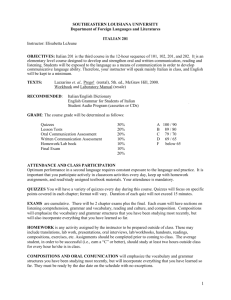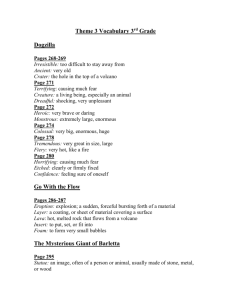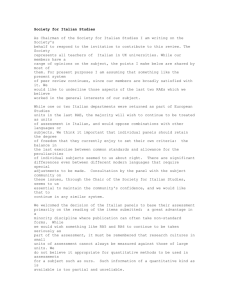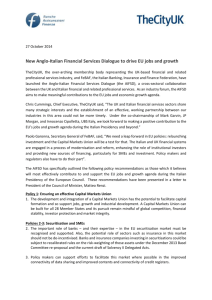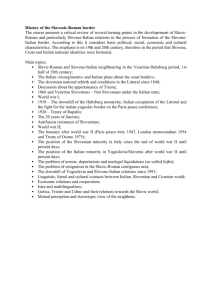ITALIAN 1001 Introduction to Italian Language and Culture I
advertisement
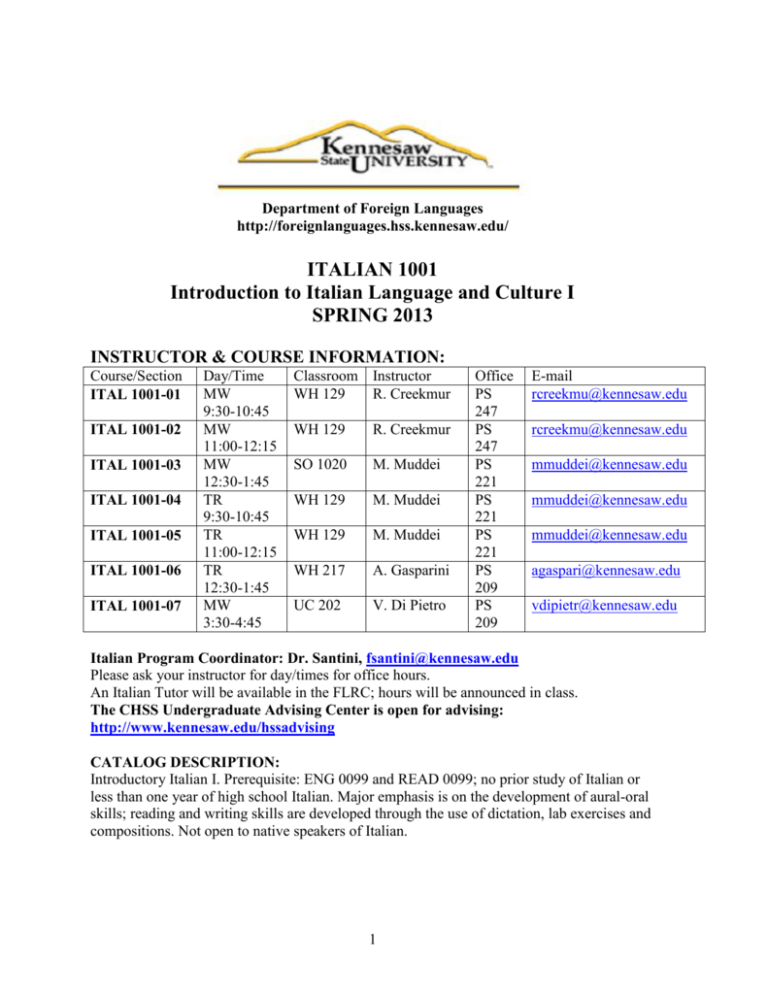
Department of Foreign Languages http://foreignlanguages.hss.kennesaw.edu/ ITALIAN 1001 Introduction to Italian Language and Culture I SPRING 2013 INSTRUCTOR & COURSE INFORMATION: Course/Section ITAL 1001-01 ITAL 1001-02 ITAL 1001-03 ITAL 1001-04 ITAL 1001-05 ITAL 1001-06 ITAL 1001-07 Day/Time MW 9:30-10:45 MW 11:00-12:15 MW 12:30-1:45 TR 9:30-10:45 TR 11:00-12:15 TR 12:30-1:45 MW 3:30-4:45 Classroom Instructor WH 129 R. Creekmur WH 129 R. Creekmur SO 1020 M. Muddei WH 129 M. Muddei WH 129 M. Muddei WH 217 A. Gasparini UC 202 V. Di Pietro Office PS 247 PS 247 PS 221 PS 221 PS 221 PS 209 PS 209 E-mail rcreekmu@kennesaw.edu rcreekmu@kennesaw.edu mmuddei@kennesaw.edu mmuddei@kennesaw.edu mmuddei@kennesaw.edu agaspari@kennesaw.edu vdipietr@kennesaw.edu Italian Program Coordinator: Dr. Santini, fsantini@kennesaw.edu Please ask your instructor for day/times for office hours. An Italian Tutor will be available in the FLRC; hours will be announced in class. The CHSS Undergraduate Advising Center is open for advising: http://www.kennesaw.edu/hssadvising CATALOG DESCRIPTION: Introductory Italian I. Prerequisite: ENG 0099 and READ 0099; no prior study of Italian or less than one year of high school Italian. Major emphasis is on the development of aural-oral skills; reading and writing skills are developed through the use of dictation, lab exercises and compositions. Not open to native speakers of Italian. 1 GENERAL OBJECTIVES: The purpose of this course is to introduce the student to the fundamentals of spoken and written Italian. All four skills (listening comprehension, speaking, reading, and writing) will be stressed. Since Italian 1001 is a basic course, vocabulary acquisition is particularly important. Students will also be exposed to the geography and cultural aspects of Italian culture. REQUIRED MATERIALS: 1. Avanti! Beginning Italian, Aski-Musumeci, 2nd edition. 2. Quia Online workbook (the pass-code is included with the textbook package if you purchase your book new at the KSU bookstore, otherwise it can be bought separately through the “Avanti!” website at www.mhcentro.com An introduction to Quia and instructions on how to register will be offered during the FLRC orientation on the first week of class.) STUDENT LEARNING OUTCOMES: This course will contribute to the attainment of the following general (GSLO) and specific (SSLO) student learning outcomes of the B.A. in Modern Language & Culture (ML&C): ML&C GSLO 1: LANGUAGE, LINGUISTICS, & COMPARISONS Learners are proficient in using the target language, are familiar with the target language system, and seek opportunities to further develop their skills and knowledge. (Knowledge, Skills, Attitudes) ML&C SSLO 1a: Demonstrating Language Proficiency Learners demonstrate a high level of proficiency in the target language, and they seek opportunities to strengthen their proficiency. (Knowledge, Skills, Attitudes) To address this outcome, learners will: - develop speaking skills by communicating in the target language, narrating and describing current events. Upon completion of ITAL 1001, learners are expected to be at the Novice-Mid level on the ACTFL scale. Assessment: in-class pair and group activities classroom presentation(s) oral exam - develop listening skills (such as listening for the gist and/or for specific information) by listening to their instructor and classmates and to recordings and videos. Assessment: in-class listening activities listening activities in QUIA listening section of tests listening components the final exam - develop writing skills by writing narratives of present events and dialogues related to everyday situations. Upon completion of ITAL 1001, learners are expected to be at the Novice-Mid level on the ACTFL scale. 2 Assessment: In-class and at home writing assignments writing section of tests writing section of the final exam - develop reading skills by reading brief texts of all kinds, including excerpts form newspaper and magazine articles, brief excerpts from literary works, web pages, and realia. Assessment: in class reading activities in-class and at home reading assignments reading section of tests reading components in the final project ML&C SSLO 1b: Understanding Linguistics Learners know the linguistic elements of the target-language system, recognize the changing nature of language, and accommodate for gaps in their own knowledge of the target-language system by learning on their own. (Knowledge, Skills, Attitudes) To address this outcome, learners will: Discuss and reflect upon the rules that govern the formation of words and sentences in the target language. Study the grammar, pronunciation and syntax of target language, applying them when communicating in the target language. Assessment: accurate use of target forms in classroom activities, homework assignments, grammar and writing sections of tests and of the final project ML&C SSLO 1c: Identifying Language Comparisons Learners know the similarities and differences between the target language and other languages, identify the key differences in varieties of the target language, and seek opportunities to learn about varieties of the target language on their own. (Knowledge, Skills, Attitudes) To address this outcome, learners will: Contrast and compare target language with native language. Assessment: accurate use of target forms in speaking and writing classroom activities, tests and in the final project ML&C GSLO 2: CULTURES & LITERATURES Learners know the literature and culture of the target language countries. They use this knowledge to interpret and reflect upon the perspectives of the target culture in relation to its practices and products. (Knowledge, Skills, Attitudes) ML&C SSLO 2a: Demonstrating Cultural Understandings. Learners demonstrate that they understand the connections among the perspectives of a culture and its practices and products. (Knowledge, Skills) 3 To address this outcome, learners will: Reflect upon the practices and products of the target culture by discussing, reading and investigating issues related to the target culture. Work with realia that are representative of different cultural aspects of the target culture. Assessment: Cultural components in homework assignments, classroom activities, classroom presentations; active participation in class discussions; culture section of tests and of the final project ML&C SSLO 2b: Demonstrating Understanding of Literary and Cultural Texts and Traditions. Learners recognize the value and role of literary and cultural texts and use them to interpret and reflect upon the perspectives of the target cultures over time. (Knowledge, Skills, Attitudes) To address this outcome, learners will: Read and discuss brief excerpts from literary and cultural texts of all genres in the target language. Assessment: Cultural components in homework assignments, classroom activities, classroom presentation(s); active participation in class discussions; culture section of tests and of the final project TENTATIVE CLASS SCHEDULE (Subject to change as necessary): WEEK TOPICS TO BE COVERED Week 1 DATES (by week, Mon.-Sun.) Jan. 9-13 OTHER INFORMATION Week 2 Jan. 14-20 Ch. 1 Week 3 Jan. 21-27 Ch. 1 Week 4 Jan. 28-Feb. 3 Ch. 1 Week 5 Feb. 4-10 TEST 1, CH. 1 Ch. 2 Quia Ch. 1 due Week 6 Feb. 11-17 Ch. 2 Composition 1 assigned Week 7 Feb. 18-24 Ch. 2 Week 8 Feb. 25-Mar. 3 Week 9 Mar. 4-10 TEST 2, CH. 2 Ch. 3 SPRING BREAK, NO CLASSES Introductions, communicative activities Monday Jan. 21: Martin Luther King, Jr. Day, No Class 4 Quia Ch. 2 due Week 10 Mar. 11-17 Ch. 3 Mar. 13: Last Day to Withdraw Without Academic Penalty Week 11 Mar. 18-24 Ch. 3 TEST 3, CH. 3 Quia Ch. 3 due Week 12 Mar. 25-31 Ch. 4 Composition 2 assigned Week 13 Apr. 1-7 Ch. 4 Week 14 Apr. 8-14 Ch. 4 Oral test on Ch. 4 (skits) Ch. 5 Week 15 Apr. 15-21 Ch. 5 Week 16 Apr. 22- 28 Ch. 5 Week 17 Apr. 29-May 1 ORAL PRESENTATIONS Quia Ch. 4 due Quia Ch. 5 due Wednesday, May 1st: Last Day of Classes FINAL PROJECTS: The final project will be a comprehensive, creative project targeted to assess linguistic, cultural and cultural skills. Guidelines will be posted and discussed two weeks prior to the end of the semester. Please check the Registrar’s Website for scheduled dates of finals. Your instructor will confirm the deadline for the final project in class. Failure to turn in the final project at the time scheduled will result in a final grade of “F”. Exceptions to this policy must be requested in writing by the student, endorsed in writing by the instructor, and approved, in writing, by Department Chair. Requests must be submitted two weeks prior to the end of the current semester. ACADEMIC INTEGRITY: Every KSU student is responsible for upholding the provisions of the Student Code of Conduct as published in the Undergraduate and Graduate Catalogs. Section II of the Student Code of Conduct addresses the University’s policy in academic honesty, including provisions regarding plagiarism and cheating, unauthorized access to University materials, misrepresentation/falsification of University records or academic work, malicious removal, retention, or destruction of library materials, malicious/intentional misuse of computer facilities and/or services, and misuse of student identification cards. Incidents of alleged academic misconduct will be handled through the established procedures of the University Judiciary Program, which include either an “informal” resolution by a faculty member, 5 resulting in a grade adjustment, or a formal hearing procedure, which may subject a student to the Code of Conduct’s minimum one-semester suspension requirement. DISABILITY POLICY: Kennesaw State University provides program accessibility and reasonable accommodations for persons identified as disabled under Section 504 of the Rehabilitation Act of 1973 or the Americans with Disabilities Act of 1990. A number of services are available to help the disabled. Students must visit the office of Disabled Student Support Services (770-423-6443) and arrange an individual assistance plan. In some cases, certification of disability is required. FINAL COURSE GRADE: The course grade for Italian 1001 will be determined as follows: Three (3) Tests @ 15% each Two (2) Compositions @ 5% each One (1) Oral Ch. Test One (1) Oral Presentation Homework and Assignments One (1) Final Project Total 45 % 10 % 5% 10 % 10 % 20 % 100 % Grading Scale: 100-90% = A; 89-80% = B; 79-70% = C; 69-60% = D; 59 and below = F Reminders: All tests are cumulative, i.e. they cover all material discussed to date. Students are responsible for all announcements and assignments made in class, even if not listed on the syllabus. Students must find out if any announcements or assignments were made in class during their absence. GENERAL EXPECTATIONS: Students are expected to attend all classes, to arrive on time and to remain in class for the entire one hour and fifteen minutes. There are no “excused” absences; for each absence in excess of two, one point will be deducted from the student’s final grade average. In other words, a student may miss two class meetings without penalty. Classes will start on time. If a student is habitually late, the instructor reserves the right to determine if a tardy constitutes an absence. Class time will be used to develop all four basic skills (listening comprehension, speaking, reading comprehension, and writing) and culture. However, a special emphasis will be put on speaking. Students are expected to study and practice at home as part of their daily preparation. All assignments, whether written or oral, are to be finished by the time class begins. No late homework will be accepted. Emergencies will be handled on an individual basis. 6 No make-up tests or assignments will be given. A grade of “0” will be assigned for all work not turned in or any tests not taken. Emergencies will be handled on an individual basis. All compositions must be one page, double-spaced. They may be hand written (if legible) or typed. Students may not use a translator program in writing compositions. Furthermore, no compositions or other work should be written or edited for a student by a native speaker of the target language, by a tutor or student assistant in the Foreign Language Resource Center, or by any other individual. Before each test, students are required to spend at least 1 hour working by themselves or with a tutor in the FLRC (hours should be recorded on the FLRC form. See the last page of this syllabus for further instructions). Oral presentation grades will be given based on group role-play. Groups will consist of 2-3 students with an assigned scenario. Each student will say a minimum of 15 lines. Lines may not be read. Props are encouraged. Groups have the option to film themselves and show the video to the class or to perform the skit in class. Please silence all cell phones and any other potentially disruptive noise makers when you arrive in class. CRITERIA FOR EVALUATION OF SPEAKING: The objective is for the student to communicate a comprehensible spoken message. The question the instructor must answer is: does the message the student is attempting to communicate make sense? These criteria are designed to help determine the comprehensibility of the student's message. • Vocabulary (is it appropriate for this level and is the student able to use it in context?) • Fluency (is the delivery so slow and halting that it interferes with comprehension, or is it beginning to be smoother and more like normal speech even though utterances may be quite brief?) • Accuracy (although speech may not be error free, is it correct enough to make sense, to be understood by individuals accustomed to dealing with non-native speakers of the target language?) Elements to be considered under the category "accuracy" are control of verb tenses appropriate to this level and comprehensibility. Speech that interferes with comprehensibility of the message should be penalized. • Pronunciation (is pronunciation accurate enough so as not to interfere with comprehension by an individual accustomed to dealing with non-native speakers of the target language?) CRITERIA FOR EVALUATION OF WRITING: The objective is for the student to communicate a comprehensible written message. The question the instructor must answer is: does the message the student is attempting to communicate make sense? These criteria are designed to help determine the overall comprehensibility of the student's message: • Content (is the argument, or content, clearly defined? Are ideas connected, clearly presented in a logical, straightforward manner and supported by examples where appropriate?) • Vocabulary (does the student demonstrate appropriate use of vocabulary in context for this level of language learning?) 7 • Organization (does the writing sample present ideas and a conclusion in a logical sequence that clearly indicates how one idea leads to the next? Are transitional devices used appropriately for this level of study? In other words, does the writing sample have a clearly stated theme, perhaps even a thesis statement, as well as a beginning, middle and end?) • Accuracy (does the student demonstrate an appropriate use of grammar at this level of language learning?) BONUS POINTS: Students can earn extra bonus points by completing cultural activities and/or lab activities. A. Cultural activities: Earn 1 bonus point by attending three different cultural events related to Italian culture and writing a brief account of the experience (200 words minimum per event). Suggestions for cultural events include: At Kennesaw: FLRC Italian movies Participation in the weekly Italian Table Activities organized by the KSU Italian Club, such as general meetings, film nights, bake sales, etc. In the community: Attending Italian events held at other universities or at venues such as museums, restaurants, etc. in the Atlanta area. Exploring the Web to learn more about the Italian-speaking world. Ask your instructor for suggestions. Watching Italian movies. B. Participation in the weekly Italian Table (for each 3 scheduled meetings to which you participate actively, you will receive 1 point; make sure to sign in with the table host, Prof. Creekmur). C. FLRC activities: Earn 2 bonus points by spending 10 hours for point in the Foreign Language Resource Center. YOU ARE REQUIRED TO SPEND ONE HOUR IN THE FLRC BEFORE EACH SCHEDULED TEST. THESE HOURS CAN BE COUNTED TOWARDS EXTRA-CREDIT. Suggestions for lab activities include: Working with a tutor Reading an Italian magazine Working on the Avanti! website Working on Quia Exploring Italian culture online Note: Tell Me More language learning software in Italian is now available in the FLRC lab. Ask one of the student tutors or the lab coordinator to check it out for use at one of the computers in the lab. 8 Each time you visit the lab, record on the FLRC form how long you have been working. A FLRC tutor, the coordinator or the director must sign the form each time. That form will be due on the day of the final if you want to receive the bonus point(s). You will receive 1 point (1% added to the final grade) for every 10 hours logged in the Multimedia Center or for every 3 cultural activities (please present documentation and/or narratives to your instructor) at the END of the semester, for a maximum of 3 points (3% added to the final grade). 9

